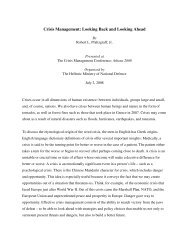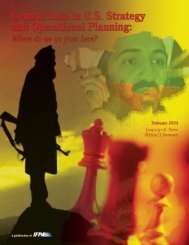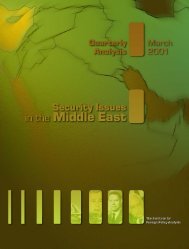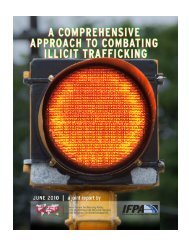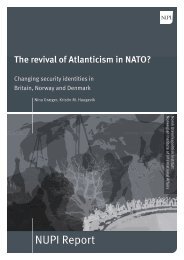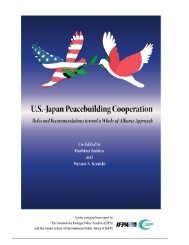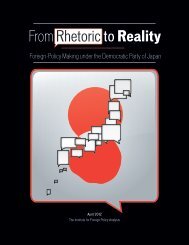US Peacebuilding in Afghanistan - Institute for Foreign Policy Analysis
US Peacebuilding in Afghanistan - Institute for Foreign Policy Analysis
US Peacebuilding in Afghanistan - Institute for Foreign Policy Analysis
You also want an ePaper? Increase the reach of your titles
YUMPU automatically turns print PDFs into web optimized ePapers that Google loves.
The G8 plan <strong>for</strong> police development was to raise a professional national police <strong>for</strong>ce of 62,000officers by December 2005, consist<strong>in</strong>g of 44,300 uni<strong>for</strong>med police, 12,000 border police, 3,400highway police, and 2,300 counter-narcotics police. 4 It was based on a European tra<strong>in</strong><strong>in</strong>g modelof police development, which <strong>in</strong>cluded “university level education <strong>for</strong> officers and a shorteracademic program <strong>for</strong> [non-commissioned officers, or NCOs]” 5 In a country with a male literacyrate under 50 percent and no stand<strong>in</strong>g police <strong>for</strong>ce from which to draw, this police developmentprogram with a target <strong>for</strong>ce of that size would have likely taken decades to complete. That sort oftime horizon was unacceptable to the United States, prompt<strong>in</strong>g it to create a parallel, but notnecessarily complementary, police development program. The United States gave theDepartment of State’s (DoS) Bureau of International Narcotics and Law En<strong>for</strong>cement Affairs(INL) the lead on establish<strong>in</strong>g seven regional police tra<strong>in</strong><strong>in</strong>g centers throughout <strong>Afghanistan</strong>.As INL is staffed by <strong>Foreign</strong> Service Officers and not law en<strong>for</strong>cement officials, it must drawupon outside expertise when undertak<strong>in</strong>g police development missions. 6 For larger operations,such as its <strong>in</strong>itial development ef<strong>for</strong>ts <strong>in</strong> <strong>Afghanistan</strong>, INL must rely upon contractors to executethe bulk of its operations, usually the contract<strong>in</strong>g firm DynCorp, because of both the lack of anational U.S. police <strong>for</strong>ce to draw upon and also its lack of <strong>in</strong>-house police expertise. INL is alsoa primary funder of the U.S. Department of Justice’s International Crim<strong>in</strong>al InvestigativeTra<strong>in</strong><strong>in</strong>g Assistance Program (ICITAP), an organization whose primary mission is to conductpolice development operations as part of U.S. <strong>for</strong>eign policy. While ICITAP would have beenthe likely U.S. government agency to provide the U.S. cont<strong>in</strong>gent <strong>for</strong> Afghan policedevelopment, they were not selected to do so. The result of INL’s ef<strong>for</strong>ts was essentially a policetra<strong>in</strong> and equip program, not a police development program, and it was executed almost entirelyby contractors with m<strong>in</strong>imal government oversight.INL’s tra<strong>in</strong><strong>in</strong>g program consisted of an eight-week basic polic<strong>in</strong>g course <strong>for</strong> literate NCOs andpatrolmen, a five-week course <strong>for</strong> illiterate patrolmen, a fifteen-day refresher course <strong>for</strong>experienced police officers, and a two-to-four-week course <strong>for</strong> police <strong>in</strong>structors. 7 This created asemi-tra<strong>in</strong>ed Afghan National Police (ANP) <strong>for</strong>ce of over 70,000 personnel by 2007. Thetra<strong>in</strong><strong>in</strong>g program was quite austere, with tra<strong>in</strong>ees <strong>in</strong> day-long classes on hard benches <strong>in</strong>classrooms with no temperature control. Instruction was given by contractors with littleexperience <strong>in</strong> police development and who did not speak the native languages and so dependedupon <strong>in</strong>terpreters with little grasp of polic<strong>in</strong>g term<strong>in</strong>ology. 8 More than 70 percent of the recruitswere illiterate, which challenged further their ability to absorb and comprehend the curriculum.4 Inspectors General, <strong>US</strong> Department of State and <strong>US</strong> Department of Defense, “Interagency Assessment of<strong>Afghanistan</strong> Police Tra<strong>in</strong><strong>in</strong>g and Read<strong>in</strong>ess,” November 2006,http://oig.state.gov/documents/organization/76103.pdf, 5.5 Bayley and Perito, 20.6 William J. Durch and Madel<strong>in</strong>e L. England, “International Police: Improv<strong>in</strong>g Professionalism andResponsiveness,” Stimson Center, Stimson Future of Peace Operations, September 2009,http://www.stimson.org/images/uploads/research-pdfs/Police_Issue_Brief.pdf, 6.7 Bayley and Perito, 21.8 Ibid.3




